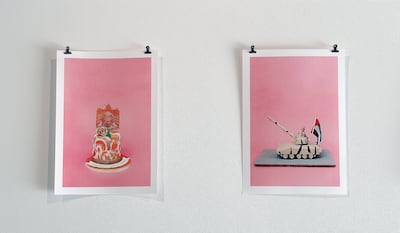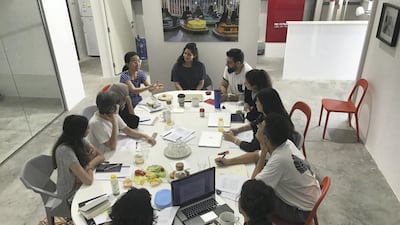For a modest one-room event held in what was essentially off-season, Saturday’s opening of the Campus Art Dubai open studio was a well-attended and sociable affair.
Housed in the Project Space Art Jameel at Alserkal Avenue, the open studio is the culmination of a six-week collaboration between Art Dubai, Art Jameel and seven participants and alumni of Campus Art Dubai, a home-grown, UAE-focused invitation-only five-month-long seminar series that will start its sixth iteration in October.
As you might expect from a studio visit, there were works-in-progress on display, but there were also children in attendance, food to eat, a video installation to watch and there was even a rosewater-flavoured cake complete with an edible UAE flag and camouflage-pattern fondant icing.
More than anything else, however, there was continuous conversation, which is quite remarkable when you consider that the participants had been speaking to each other, week in and week out, since October 2016.
That conversation gets to the heart of what Campus Art Dubai (CAD) is all about. The programme combines the kind of reading lists and discussion groups that you might expect to encounter in a post-graduate setting with field trips, presentations, guest speakers and one-to-one tutorials from the locally-based artists, curators and academics who lead the sessions.
Rather than talking about art, however, CAD is more about talking around it, and about creating a forum for honest and open discussion that allows each cohort of participants to get to grips with what it means to live and work in the emirates while engaging with the place critically.
In the past CAD has attracted a wide range of participants, from artists and writers, architects and archaeologists to photographers, curators and economists, many of whom go on to figure prominently in the UAE’s cultural scene.
These include the UAE-based artists Vikram Divecha and Lantian Xie – a long-term CAD tutor - whose work formed part of Rock, Paper, Scissors: Positions in Play, the UAE National Pavilion at this year's Venice Bienniale.
An invisible college with no staff and no buildings, CAD aims to provide its participants with the kind of intellectual workout that they cannot find elsewhere in the emirates while providing returnees to the UAE with a stimulating welcome home.
Mona Ayyash is a Dubai-based artist who spent three-and-a-half years studying at Concordia University in Montreal, Canada, after completing her undergraduate studies in photography at the American University in Dubai.
“Even though I grew up here, I felt like I didn’t really know how to fit back in and after spending time thinking about your work and art it becomes part of your everyday,” she tells me.
“You feel the need to speak about it with like-minded people so it was really good to come back and meet people who were interested in the same topics and in talking about the city.”
Nadine Ghandour is another Dubai resident and CAD alumna who returned home to the UAE after several years abroad.
“You have to learn a lot of things we you come back in order to reorient yourself,” the illustrator says, reflecting on the process of returning from her studies at the Camberwell College of Art in London.
“It makes a difference if you are from here. There’s a specific language that you use when you talk about the place that has to be learnt and I think it’s important to invest time in developing ways to speak to people and about this place so that you don’t feel isolated.”
For Layan Attari, a graphic designer and artist who grew up in Sharjah, having a programme like CAD whose content is often highly-theoretical and locally-focused means that she has been able to develop her practise and ideas without having to leave the UAE.
“If you’re going to pursue graduate studies, you’d normally end up in the West, but I think the tutors make lot of effort coming up with readings that are relevant to this place and the wider region,” says Attari, who has participated in CAD twice, first in 2015 and then again in 2016.

“It’s been really helpful for producing my own work. Before CAD my work was very technical, but there’s a lot of reading and a lot of theory and you are challenged to push yourself to think, particularly about the work you produce, and to think about who you are producing it for.”
Developing a sense of community, a notion of who the audience might be for UAE-based art and cultural production and a relevant grammar for engaging with and discussing Dubai are all central to Lantian Xie’s vision for CAD.
For the last three years, the Dubai-based artist has been one of the programme’s three main tutors alongside Uzma Z Rizvi, an associate professor of anthropology and urban studies at the Pratt Institute of Art and Design in New York and a visiting scholar in the department of International Studies at the American University of Sharjah and the curator Murtaza Vali.
"CAD is designed to privilege people who are living in and actively thinking about the emirates, that make from this place about this place in this place and with this place," he tells me, making no apologies for CAD's local emphasis.
“It grew out of conversations with Antonia Carver at a time when there weren’t distinctions about what galleries and museums and art schools did when people were asking for these things and those of us who grew up here felt that we had an idea about what might be useful.”
Like many of the participants in CAD, Xie grew up in the UAE, in Sharjah and Dubai, but then studied abroad at the School of the Art Institute of Chicago before making a conscious decision to return home.
__________________________
Read more:
Architecture: AAU Anastas's While We Wait at the V&A and Concrete in Dubai
Vantage Point Sharjah 5: an urban portrait of Arabia
Omar Kholeif on curating for Abu Dhabi Art
__________________________
“We wanted to avoid a pedagogy of revolving doors were people would parachute in, smile at the camera and then leave and never be seen again, which happens a lot here so we wanted to build something that has an ongoing conversation built,” Xie explains.
“That’s why we encourage applications from people who have already taken part so that some of the conversation carries over.”
Last year, for CAD 5.0, the group who are now exhibiting in the CAD open studio were invited to investigate and discuss issues relating to how people and creatives in Dubai and the UAE engage with different environments, communities, audiences and publics.
For the forthcoming CAD 6.0, which begins in October, participants will be looking at the issue of genre and how these can be used as a means of overcoming lazy and stereotypical thinking about Dubai.
“By saying that we are going to talk about genre for the next six months, that’s very much an invitation. We don’t know where that will lead,” the artist admits.
“But we wanted to take something as a concept that is multi-disciplinary and that can cut through disciplines and landscapes and that would act as a kind of technology that can help frame a place,” he adds.
“What would it be to think about Dubai as a romantic comedy or as an action adventure?”
As well as tutoring CAD and participating in the Hamad Nasar-curated UAE National Pavilion at 57th Biennale in Venice, Xie’s work was also recently exhibited in The New Normal, a group show at the UCCA in Beijing and in a Raqs Media Collective-curated show at the 11th Shanghai Biennale.
“People have flown in for the duration of the course and sometimes might come in who are very new to Dubai or the Gulf but we usually try to have the centre of the conversation here and we are looking for participants who will challenge us and not to agree with us,” Xie explains.
“But we also get a lot of folks who have grown up here and spent time here and we are very welcoming of them. We are not looking at this place from the outside and I think the person who has been here for two days should have a definite disadvantage,” he adds.
“The programme isn’t concerned with manufacturing careers for people or with professionalising them into artists with a capital ‘A’, we’re more interested in making people more confused and more thoughtful and building capacity for them to look at things and think about them more actively.”
The Campus Art Dubai open studio continues until September 4 and the deadline for applications to next edition of Campus Art Dubai (CAD 6.0) is September 7, 2017. For details visit www.artdubai.ae

